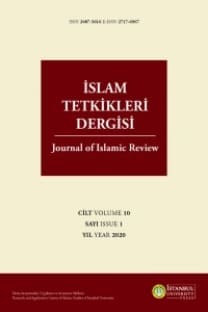Müphemlik Bir Kültür Oluşturur mu?: Alternatif Bir Kültür Tarihi Yazımında Anakronizmin Yeni Oryantalizme İzdüşümü
Anahtar Kelimeler:
Müphemlik, Hoşgörü, İslam, Kültürel Tarih, İslamileştirme
Does Ambiguity Create a Progressive Culture? The Projection of New Orientalism in an Alternative Cultural History Writing
Islam has constantly commanded considerable attention within Western intellectual circles, leading to the construction of diverse perceptions. In his renowned literary work, A Passage to India, E. M. Forster adeptly portrays the intricate web of perplexity and differing perceptions surrounding the Muslim world The novel encapsulates numerous thought-provoking facets, with paramount emphasis placed on the pivotal juncture of the narrative, embodied by the Marabar Caves. Within the narrative, the characters Miss Adele Quested, an emblem of English refinement, and Mrs. Moore, a longstanding friend of Dr. Aziz, are extended an invitation to embark on an expedition to the Marabar Caves. These caverns, veiled in obscurity and possessing confined dimensions, become the backdrop for a critical turning point. In this context, Adela Quested, grappling with psychological instability, encounters a perplexing auditory phenomenon within the Marabar Caves, which profoundly affects her. Abruptly departing the caves, she is consumed by an amalgamation of anger and exasperation, subsequently levying accusations against Dr. Aziz, contending that he harbored hostile intentions and assaulted her. Ironically, her distressing experience within the caves merely involves the repetition of a solitary sound, “bou-oum”, reverberating through the darkness. This strange sound is heard by the antagonized figure, Dr. Aziz, as well. However, this auditory phenomenon engenders profoundly disparate interpretations from the diametrically opposed vantage points of the British ruling elite and the Indian Muslim community, both pivotal in the unfolding legal proceedings. Remarkably, for the British, the alleged transgression serves as yet another corroborative instance fortifying their prevailing preconception of an uncultivated Muslim society, characterized not only by diminished intellectual acumen but also by an aesthetic allure inferior to that of their white counterparts within the upper echelons of society. Consequently, this auditory echo emerges as a poignant metaphor emblematic of the inherent tensions arising from cross-cultural interactions and the combination of conflicting perceptions. Nearly a century subsequent to the publication of Forster’s novel, the reverberations of the same auditory echo endure in the intellectual milieu, retaining an inherent capacity to evoke profoundly intriguing images within Western intellectual spheres.
Keywords:
Ambiguity, Tolerance, Islam, Cultural History, Islamization,
- Yayın Aralığı: Yılda 2 Sayı
- Başlangıç: 1953
- Yayıncı: İstanbul Üniversitesi
Sayıdaki Diğer Makaleler
Mahmud Sâmi Bârûdî’nin Şiirlerinde Neoklasik Unsurlar
Hanefî-Eş‘arî Ebû Cafer es-Simnânî ve Kendisine Yönelik İthamlar
İslam’ın Klasik Çağında Ṣāḥibu Sünne Unvanı: Sünnîlik Nasıl Oluştu
Musa EŞİT, Çevirmen: Musa EŞİT
Finansal Kiralama Sözleşmesinin Hukuki Niteliğine Dair Tartışmalar
Borçlanma Yetkileri Açısından Vakıf ile Trust Yöneticilerinin Mukayesesi
